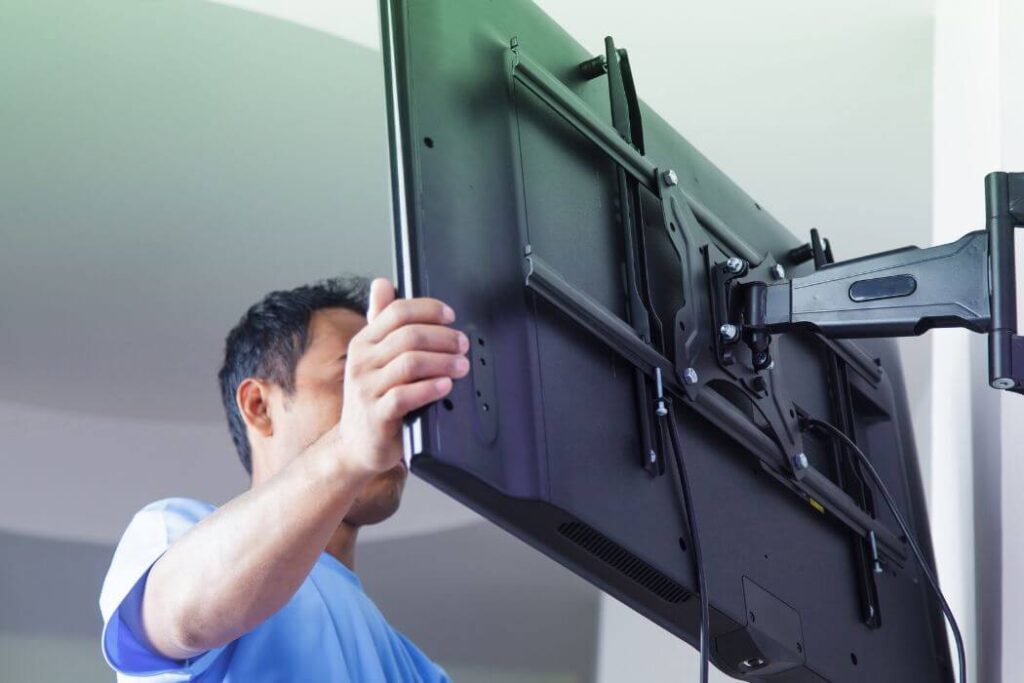Electronics are among the most challenging items when moving to a new home. They can be fragile, expensive, and difficult to repair if anything goes wrong. The most crucial electronic device to pack correctly can be the TV. Yes, it’s the end of massive, bulky CRT televisions in the 2000s! Televisions come in various dimensions and shapes, from compact and large portable models to huge and slim Plasma OLED LCD entertainment centers.
If you pack your TV improperly, it could cause damage to the frame, screen, or even the cords. Therefore, taking the proper precautions in packing your TV to move is crucial.
How to Pack Your TV Safely
The model. Televisions with flat screens are becoming more popular. However, their weight and size can be challenging to transport. Televisions of the present are thinner than their predecessors and are, therefore, more susceptible to damage. They can also be expensive concerning their model, brand, and size. Like other appliances, televisions shouldn’t be positioned on their backs during a move.
The proper packing of a TV will ensure that you get it to your next home in good condition and in perfect operating in good condition. Here are some tips regarding how you can pack TV for moving.
Collect the materials
You’ll require a few items and tools to pack your television properly. This includes:
Tools:
-Scissors
-Marker
Moving blankets
-Screwdriver
Supplies:
-Flatscreen TV Cover
-Packing paper
-Bubble wrap
-Packing Tape
-Strong-packing TV box
-Corner Protectors
-Plastic Bags
-Foam pads
-Furniture blankets
A few TVs also include special cleaning cloths or items that can shield the screen LCD during a move. If you don’t own all of these items generally, you could buy these items from a moving company or hardware stores. Be sure to store the items in a safe location in order to avoid losing them.
Set up a specific location to place your television
Having an ample open space is necessary to accommodate your TV correctly. This could be in a room in your home or the garage. Once you have chosen an area, lay your TV on its side and cover it with moving pillows or sheets on top. Lay out your packing items in an area that is easily accessible to grab everything you require while packing.
Make sure you select a tidy area with no dust, clutter, debris, or children who may cause damage to your television.
If you can, try to avoid packing your TV away from direct sunlight or close to hot sources. It could cause damage to the screen glass, the screen, or other fragile components. It’s recommended to have someone available to help you pack and move your television. If you’re packing more than one TV Label each box to ensure you know which will be in the room in which.
Remove the TV from its mount.
The TV must be removed from the wall if it is wall-mounted. You will need to remove the bracket from the TV and remove it off the wall. It is always advisable to refer to the manufacturer’s instruction manual if you need clarification about how to disconnect the TV correctly.
Assistance when removing the huge television is a great idea. Even if the TV is relatively light, moving a big TV by yourself is daunting. If you have a base that supports your TV, then you must remove the base so you can move the TV more effectively. In most cases, a screwdriver is required for this.
Disassemble your TV
Photograph how everything is connected before beginning to dismantle your entertainment system. If required, you could make use of your pictures to help you reassemble the items at your new residence.
Take all cable TVs from behind. Locate the power cord and carefully coil it up. Place the remote(s) and the power cord into a clear plastic bag or any other small container. The remote should be kept in a secure place for future use.
Removing your television from your legs or stands when connected is imperative. A screwdriver can remove the portions or frames. To remove them safely, you must place the TV’s screen on a blanket or towel on an even surface.
Screws should be placed inside the same bag container that houses the remote and power cord. It is also possible to put the screws in an additional moving box.
Unplug all cables and accessories.
It is necessary to disconnect any cables or cords connected to your TV. These are the following:
HDMI cord
Audio/visual (A/V) cables
Ethernet cables
Power cord
-Cable/satellite box.
It is also recommended to unplug all devices connected to your TV, including the soundbar or DVD player, as well as a gaming console. It’s best to keep cables and cords separated by color so that you can quickly connect everything to your new home.
Put all cords and accessories in the Ziploc bag and mark it with a label.
When you have all the cords unplugged, make sure to keep everything in place.
– Place all cords and accessories in the Ziploc bag.
-Attach it to the outside of the box.
-Label it.
– Pack the corded items in an additional moving box.
-Place them in a safe place so you can find them later.
If you own an audiobook, DVD player, or gaming console, you’ll have to store these items separately. Check the manufacturer’s instructions on the correct packing and moving.
Cleanse the TV’s screen using a microfiber cloth
Before packing, use a soft, dry microfiber fabric to clean your TV screen lightly. This will remove any fingerprints or dust that may damage your screens during the move.
If you own an LCD TV, you should use a complete cleaning solution made specifically for plasma screens. These solutions are available at the majority of electronic stores.
Ensure you don’t contact the screen directly because this can leave more fingerprints or smudges behind.
It’s also good to wash your bezel (the frame surrounding the screen) behind the television and stand. Use the dust cloth or vacuum attachment to eliminate dirt or dust.
Make sure the screen is protected by covering it with plastic wrap, blankets, or bubble wrap.
After cleaning the TV screen, you’ll have to shield it like any other piece of furniture. It doesn’t matter how simple it is. Pressing your finger with a strong force could cause harm. Before moving it, ensure you protect your TV’s screen against scratches, dents, or any other damage. The screen can be covered with blankets, plastic, or other fabrics.
Your TV box likely had a foam covering. You could also utilize bubble wrap to protect the screen in the event of a need. If you don’t have one, you can also find a flatscreen TV cover from the local hardware store or shipping supply stores.
Be cautious when handling the wrapped television to ensure you don’t hit or drop it on something.
Cover the edges of your television
Most television moving kits come with corner protectors that prevent your TV from being damaged, damaged, or moved around within the box. Utilizing corner protectors in moving your computer mirrors and picture frames could be an excellent idea.
Attach the corner pieces to the flatscreen’s four corners with packaging tape. Utilize the box inserts on the TV if you possess the box packaging.
If you don’t have the box you bought, other padding options are bubble wrap and Styrofoam peanuts. You can also create corner protectors by cutting strips of cardboard into triangles or squares and gluing them to the edges of the television.
TV box within the original box
After you’ve got your TV fully padded after which it’s time to put it in a box; if you have the box your TV originally arrived in, this is the best option since it already has the proper padding and support for your TV.
However, most of us need to possess the first box in the house. If that’s the case, you’ll have to buy a TV box that’s adequate to fit your particular model. Take a measurement of your TV before going to the shop to determine what size box you need. Better yet, you can design your TV packaging.
You’ll require packing equipment, which includes:
-Packing tape
-Bubble wrap
-Moving blanket
-Box cutter
-Any box that has a wardrobe or a box
Find the dimensions of the TV first, then locate the smallest box. This will allow you to have more space to cut out pieces.
Place cushions in the empty spaces
After your TV is installed in the box, it’s time to put in cushioning material. The package could contain a lot of room because most packing boxes are made to work with various TVs. The boxes you created won’t match the TV you have. To ensure that your TV remains safe, try packing things like newspaper, peanuts, and Bubble wrap in the space. Pack it tightly to ensure that the TV won’t move around.
Put the TV inside the expandable box, and ensure it fits correctly.
Expandable boxes are a robust box that is ideal for holding the TV. You can locate an expandable box at your local hardware store or store selling shipping supplies. Place your TV in the box, and ensure that it is snugly seated without additional space. You’ll want to keep as much movement as possible to ensure your TV isn’t damaged in transit.
If your TV is too big for the box, you may look for another larger box or consider having a custom-designed box.
Securely tape and label the TV using fragile.
The last step is to look for gaps or holes, close the box with tape and mark it “fragile” or “this side up.” This will inform the movers or anyone handling the box that there’s a television inside. Be careful.
If you’re still using your original TV, take your model’s name down. Also, any other information you consider essential to use while setting up your TV for the second time.
Make sure you stand straight and adequately load the TV.
Always keep the box in conjunction while the TV is in a straight place. This helps protect the screen from getting damaged. When you are loading the TV onto the truck, make sure to place it toward the front. This will ensure that it is kept from being tossed around as frequently and may break. If you have any other furniture or boxes over it, put it in a secure place to ensure it won’t tip over.
Now it’s time to move the TV! Be sure to move your legs upwards, not your back, and you’ll be ready to roll.
Gently unpack the TV.
Once you arrive at your new home, take the TV off your moving truck and take it out of the box. Remove it gently from the crate and place it on a level surface. If you’ve employed the expandable method, remove the packing material, so it doesn’t damage the screen.
It’s also a method to ensure that the TV makes a move without causing any damage. Once you’ve established that it’s functioning correctly, then you can put the TV up. That’s it! You’ve successfully transferred your TV.
We can help you with Your Broken Items!
We at The Long Distance Moving Company of Sarasota Co. understand that packing for the move can be challenging and stressful. But with some planning and attention to detail, you’ll quickly complete the task. Contact us if you need assistance, and we’ll be glad to help you pack or move your items on your behalf. We’ve got the experience and expertise to do the job correctly. If you’ve learned how to pack, you’re ready to load your bags like a professional! Request a quote today!












